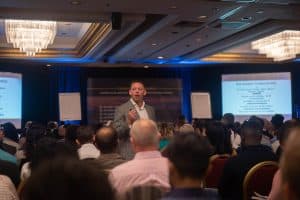
Best Property Investment Courses in the UK
Discover top-rated UK property investment events, bootcamps, and mentors, including Martin Roberts, Stuart and Scarlette

In this blog post, I’ll be delving into brownfield sites – often an overlooked chance for property development. I’ll cover why they tend to be unpopular with investors, the things to look out for when considering purchasing a brownfield site, and some food for thought about their possible constructive use.
Table of Contents
ToggleBrownfield sites refer to any parcel of land which has been previously developed. It relates to anything that was either occupied by a permanent structure in the past or is currently built on, but the buildings or premises are no longer in use. Brownfield land holds huge potential for development, and means less green space is used up for building – as well as putting wasted land back into good use.
As the UK is unlikely to magically gain more land, the consensus is to make use of what land we have, instead of letting brownfield sites stand and rot. Getting rid of green land is also a surefire way to accelerate climate change, as well as reduce the number of natural spaces available.
Due to the hard-to-define nature of brownfield land sites, registering brownfield land with a brownfield register helps to discern whether a brownfield site is suitable for development. They provide up-to-date information on the appropriateness of brownfield land for residential development, according to certain criteria, and make the job of deciding whether to build on them much easier for local planning authorities.
There are some factors which the local planning authority must be aware of before entering land onto a brownfield register, including these 3 factors:
It is important to note that any greenfield land within the curtilage of a brownfield site is not to be included in the brownfield land registry. The bounds should be properly defined, and in any case, where it is unclear whether sections of the site are classed as previously developed land, only the clearly defined brownfield of the site should be considered for planning permission.
Brownfield sites are built-up land that may be contaminated by industrial pollution, meaning there will be more work involved in purifying the area before work can begin. However, greenfield sites, which are previously undeveloped examples of land, such as woodland or grassland, are often contrasted against brownfield land when choosing which to develop.
Greenfield land is much easier to use for property development, as it is often a quicker process because the site is ready to build on straight away. However, the consensus has long been that greenfield land should be left to nature and used as a last option for development, to protect the environment and England’s wildlife.
No matter the type of land being built on, it must abide by the National Planning Policy Framework, and not cause unnecessary damage or adverse impact to the built, natural or historic environment.
Data from 2019 indicates that there is enough brownfield land available in the UK to build more than 1 million homes across a whopping 26,000 hectares. 4 key ebnifits are:
Although there are many benefits to developing properties on brownfield land, there are also many things to take into account, such as the higher upfront costs that come with decontaminating old industrial sites – particularly if the land is sizable.
Brownfield sites vary widely in terms of size, location, and suitability for repurposing, making it difficult to discern whether they are a worthwhile investment. It’s often better to decide on development on a case-by-case basis, taking into account their specific attributes as part of the decision. Additionally, disused sites may have already become a haven for nature, even if they don’t look visually appealing – and their biodiversity would be scrubbed out if they were to be redeveloped carelessly.
What tends to be the case with brownfield is that it’s bought for non-affordable luxury housing – as there’s such a big cost associated with cleaning the land, developers aim to close the margins by pricing high, which in turn makes the new development inaccessible for those with lower incomes.
The UK Government is pushing for brownfield land to take the brunt of new developments, instead of losing more precious greenfield land. Its long-term housing plan, announced on 13th February 2024, included the previous Brownfield Land Release Fund, in which local councils were provided with funding to prioritise brownfield development.
The plan also includes measures to make the bar higher for refusing brownfield developments, house building target agreements and normalising the ‘brownfield first’ approach to new developments. This will no doubt see a rise in readily available housing, especially when done with enough consideration to minimise the tricky intricacies putting so many people off investing in brownfield previously.
Planned brownfield sites (as of 2024) include sites in places like Chorley, Blackburn and Darlington, which have just been awarded funding to regenerate their brownfield land.
For more information, tailored specifically for investors and developers, attend one of Assets For Life’s online property, management and wealth events to learn about how to make the property market work for you. Top property investment experts will be providing in-depth knowledge on how to successfully invest in and develop property.
You May Also Be Interested In...

Best Property Investment Courses in the UK
Discover top-rated UK property investment events, bootcamps, and mentors, including Martin Roberts, Stuart and Scarlette

How to Make a Million Pounds from Property Investing
Discover how to earn £1 million through UK property investing with practical strategies and expert

How To Grow A Property Portfolio – Free Online Training
Grow your UK property portfolio from scratch with expert tips, creative strategies and free online
Featured Property Investment Events & Courses
The Property Deal Packaging Summit
The Property Millionaire Bootcamp
The Serviced Accommodation Bootcamp
Assets For Life LTD is a company incorporated in England and Wales with registered number 09935286 and registered offices at Assets for Life Ltd, Suite 105, Waterhouse Business Centre, 2 Cromar Way, Chelmsford, Essex, England, CM1 2QE, United Kingdom.
Assets For Life LTD is registered with the Information Commissioner’s Office, with registration number ZA280607
COPYRIGHT © 2024 ASSETS FOR LIFE, ALL RIGHTS RESERVED. WEBSITE BY AMPLIFY MARKETING